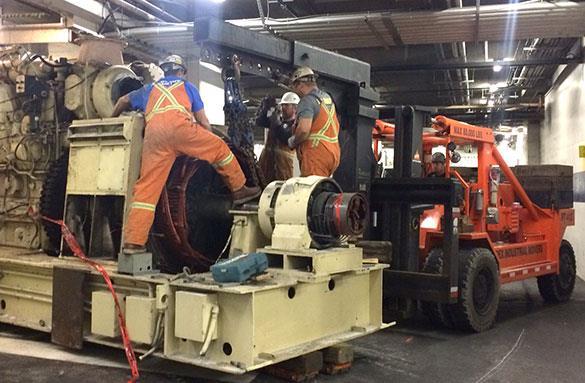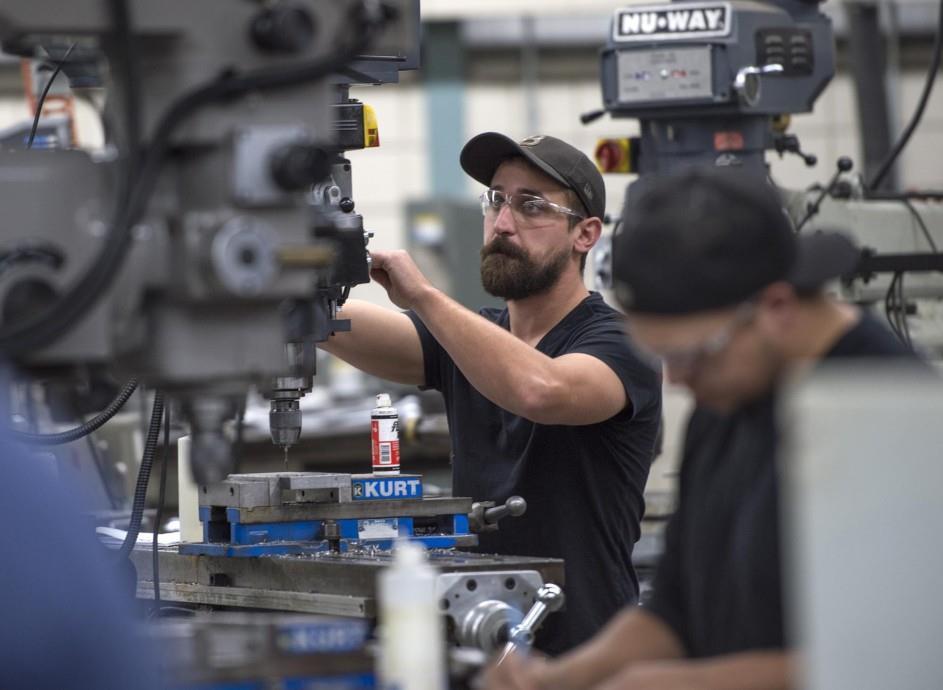Table of Contents Introduction........................................................................................................ 3 Understanding the Millwright's Role................................................................... 3 Definition and Importance............................................................................... 3 Historical Context ............................................................................................ 3 Key Responsibilities of a Millwright .................................................................... 4 Installation of Machinery................................................................................. 4 Maintenance and Repair.................................................................................. 4 Precision Alignment 4 Common Challenges Faced by Millwrights.......................................................... 4 Physical Demands ............................................................................................ 4 Technological Advancements .......................................................................... 4 Safety Hazards ................................................................................................. 4 Skills Gap ......................................................................................................... 5 Equipment Malfunctions ................................................................................. 5 Tight Deadlines ................................................................................................ 5 Job Complexity ................................................................................................ 5 Overcoming Physical Demands........................................................................... 5 Ergonomics and Proper Lifting Techniques ...................................................... 5 Regular Exercise and Stretching....................................................................... 5 Use of Personal Protective Equipment (PPE) ................................................... 5 Adapting to Technological Advancements .......................................................... 6 Continuous Education and Training ................................................................. 6 Embracing New Tools and Software 6
Collaboration with Engineers and IT Professionals .......................................... 6 Ensuring Safety on the Job.................................................................................. 7 Comprehensive Safety Training ....................................................................... 7 Regular Safety Audits....................................................................................... 7 Safety Protocols and Emergency Procedures................................................... 7 Bridging the Skills Gap ........................................................................................ 7 Apprenticeship Programs ................................................................................ 7 Mentorship and On-the-Job Training............................................................... 7 Technical Education and Certifications ............................................................ 7 Dealing with Equipment Malfunctions................................................................ 8 Preventive Maintenance Strategies ................................................................. 8 Troubleshooting Techniques............................................................................ 8 Inventory Management for Spare Parts 8 Managing Tight Deadlines................................................................................... 8 Efficient Project Planning................................................................................. 8 Time Management Skills.................................................................................. 8 Communication and Team Coordination ......................................................... 8 Simplifying Job Complexity ................................................................................. 9 Standard Operating Procedures (SOPs)............................................................ 9 Utilizing Advanced Diagnostic Tools................................................................. 9 Delegation and Teamwork............................................................................. 10 Case Studies: Real-Life Challenges and Solutions.............................................. 10 Success Stories from the Field ....................................................................... 10 Expert Insights .................................................................................................. 10 Quotes from Experienced Millwrights ........................................................... 10 Conclusion ..................................................................................................... 10 FAQs .............................................................................................................. 11
Introduction
Millwrights are skilled tradespeople responsible for installing, maintaining, and repairing industrial machinery in factories, power plants, and construction sites. Their role is critical in ensuring the smooth operation of various mechanical systems, contributing to productivity and safety in industrial settings. However, millwrights face numerous challenges in their line of work. This article delves into these challenges and offers practical solutions to overcome them.
Understanding the Millwright's Role
Definition and Importance
Millwrights are skilled tradespeople responsible for installing, maintaining, and repairing industrial machinery in factories, power plants, and construction sites. Their expertise is crucial for ensuring the smooth operation of various mechanical systems, thereby enhancing productivity and safety in industrial settings.
Historical Context
The term "millwright" originated in the Middle Ages when these craftsmen were tasked with constructing and maintaining the intricate machinery used in mills, such as grain mills and watermills. Over time, the role evolved to encompass a broader range of industrial machinery across various sectors.

Key
Responsibilities
of a Millwright
Installation of Machinery
Millwrights are proficient in assembling and installing complex machinery according to blueprints, specifications, and safety standards. This involves precise measurement, alignment, and integration of mechanical components.
Maintenance and Repair
Regular maintenance is essential for preventing machinery breakdowns and optimizing performance. Millwrights conduct inspections, lubrication, and replacement of parts to ensure equipment reliability and longevity. In case of malfunctions, they diagnose issues and perform repairs promptly to minimize downtime.
Precision Alignment
Accurate alignment of machinery components is critical for efficient operation and longevity. Millwrights utilize precision instruments and techniques to align shafts, gears, couplings, and other components within tight tolerances.
Common Challenges Faced by Millwrights
Physical Demands
The nature of the millwright profession involves working in physically demanding environments, often requiring lifting heavy objects, working at heights, and operating machinery. This can lead to fatigue, musculoskeletal injuries, and overall strain on the body.
Technological Advancements
Advancements in technology, including automation, digitalization, and computerized systems, have transformed industrial machinery. Millwrights must continually update their skills and knowledge to adapt to these changes and operate new equipment effectively.
Safety Hazards
Working with heavy machinery poses inherent risks, including mechanical hazards, electrical hazards, and exposure to hazardous materials. Ensuring safety protocols and practices are followed is paramount to prevent accidents and injuries on the job.
Skills Gap
The evolving nature of industrial technology has created a skills gap, where traditional craftsmanship intersects with modern engineering and technology. Millwrights need to acquire new skills and competencies to bridge this gap and remain competitive in the industry.
Equipment Malfunctions
Despite regular maintenance, machinery breakdowns and malfunctions can occur unexpectedly, leading to unplanned downtime and production losses. Millwrights must possess strong troubleshooting skills to diagnose issues quickly and implement effective repairs.
Tight Deadlines
Industrial projects often operate on tight schedules, requiring millwrights to complete tasks within limited time frames. Meeting deadlines requires efficient planning, coordination, and resource management to ensure project milestones are achieved on time.
Job Complexity
The complexity of modern industrial machinery presents challenges in understanding and troubleshooting intricate systems. Millwrights must possess a deep understanding of mechanical principles, electrical systems, and computerized controls to tackle complex problems effectively.
Overcoming Physical Demands
Ergonomics and Proper Lifting Techniques
Millwrights should receive training in ergonomic principles and safe lifting techniques to minimize the risk of musculoskeletal injuries. This includes proper body mechanics, use of lifting aids, and avoiding repetitive strain.
Regular Exercise and Stretching
Engaging in regular exercise and stretching routines can improve strength, flexibility, and overall physical fitness, reducing the likelihood of injuries and fatigue on the job.
Use of Personal Protective Equipment (PPE)
Wearing appropriate PPE, such as gloves, safety glasses, hard hats, and steel-toed boots, provides additional protection against workplace hazards and injuries.
Adapting to Technological Advancements
Continuous Education and Training
Millwrights should participate in ongoing education and training programs to stay abreast of technological advancements and industry best practices. This may include workshops, seminars, online courses, and manufacturer certifications.
Embracing New Tools and Software
Familiarizing themselves with new tools, software applications, and diagnostic equipment enables millwrights to work more efficiently and effectively with modern machinery.
Collaboration with Engineers and IT Professionals
Collaborating with engineers, IT specialists, and other professionals can provide valuable insights and support in implementing technology-driven solutions and troubleshooting complex issues.

Ensuring Safety on the Job
Comprehensive Safety Training
Employers should provide comprehensive safety training to millwrights, covering hazard recognition, risk assessment, emergency procedures, and use of safety equipment. Regular refresher courses and safety drills help reinforce safety protocols.
Regular Safety Audits
Conducting regular safety audits and inspections helps identify potential hazards and compliance issues in the workplace. Addressing these findings promptly improves overall safety performance and reduces the risk of accidents.
Safety Protocols and Emergency Procedures
Establishing clear safety protocols and emergency procedures ensures that millwrights are prepared to respond effectively to accidents, injuries, and equipment failures. This includes evacuation plans, first aid training, and communication protocols.
Bridging the Skills Gap
Apprenticeship Programs
Apprenticeship programs provide hands-on training and mentorship opportunities for aspiring millwrights to develop practical skills and knowledge under the guidance of experienced professionals.
Mentorship and On-the-Job Training
Pairing junior millwrights with experienced mentors facilitates knowledge transfer and skill development in a real-world work environment. On-the-job training allows apprentices to learn from seasoned professionals and gain valuable insights into industry practices.
Technical Education and Certifications
Formal education programs and certifications inmechanical engineering, industrial maintenance, and related fields equip millwrights with the technical knowledge and credentials needed to excel in their careers.
Dealing with Equipment Malfunctions
Preventive Maintenance Strategies
Implementing preventive maintenance programs, including regular inspections, lubrication schedules, and predictive maintenance techniques, helps identify and address potential issues before they escalate into major failures.
Troubleshooting Techniques
Developing strong troubleshooting skills enables millwrights to diagnose equipment malfunctions quickly and accurately. This involves systematic problem-solving methods, logical reasoning, and familiarity with machinery operations.
Inventory Management for Spare Parts
Maintaining an adequate inventory of spare parts and critical components ensures timely repairs and minimizes downtime during equipment breakdowns. Effective inventory management practices, such as Just-In-Time (JIT) procurement and vendor partnerships, optimize spare parts availability while minimizing storage costs.
Managing Tight Deadlines
Efficient Project Planning
Effective project planning involves breaking down tasks, allocating resources, and setting realistic timelines to meet project objectives within budget and schedule constraints. Utilizing project management tools and techniques streamlines planning processes and enhances project visibility.
Time Management Skills
Strong time management skills enable millwrights to prioritize tasks, allocate time efficiently, and meet deadlines effectively. This includes setting goals, minimizing distractions, and optimizing workflow processes.
Communication and Team Coordination
Clear communication and collaboration among team members are essential for coordinating tasks, resolving conflicts, and ensuring project milestones are met on time. Regular meetings,
progress updates, and feedback mechanisms facilitate effective teamwork and alignment of objectives.

Simplifying Job Complexity
Standard Operating Procedures (SOPs)
Documenting standard operating procedures for common tasks and processes provides clear guidance and consistency in job execution. SOPs outline step-by-step instructions, safety precautions, and troubleshooting protocols to streamline operations and reduce errors.
Utilizing Advanced Diagnostic Tools
Utilizing advanced diagnostic tools, such as vibration analyzers, infrared thermography, and condition monitoring systems, enhances millwrights' ability to identify equipment issues and perform predictive maintenance. These tools provide valuable insights into machinery health and performance metrics.
Delegation and Teamwork
Delegating tasks and responsibilities among team members leverages collective expertise and resources to tackle complex problems efficiently. By leveraging the strengths of each team member and fostering a collaborative environment, millwrights can effectively address job complexity and achieve better outcomes.
Case Studies: Real-Life Challenges and Solutions
Success Stories from the Field
Sharing success stories from experienced millwrights highlights effective strategies and solutions for overcoming common challenges in the industry. These stories provide valuable insights and inspiration for aspiring millwrights and underscore the importance of continuous learning and innovation in the field.
Expert Insights
Gaining insights from industry experts, including seasoned millwrights, engineers, and safety professionals, offers valuable perspectives on emerging trends, best practices, and innovative solutions. Expert interviews, panel discussions, and knowledge-sharing sessions enrich the discourse and foster professional development within the millwright community.
Quotes from Experienced Millwrights
Incorporating quotes and testimonials from experienced millwrights adds authenticity and credibility to the article, providing firsthand perspectives on the challenges and rewards of the profession. These quotes capture the wisdom, experience, and passion of seasoned professionals, inspiring others to overcome obstacles and strive for excellence in their careers.
Conclusion
Millwrights play a vital role in installing, maintaining, and repairing industrial machinery, contributing to the efficiency, productivity, and safety of various industries. However, they face numerous challenges, including physical demands, technological advancements, safety hazards, skills gaps, equipment malfunctions, tight deadlines, and job complexity. By implementing practical solutions such as ergonomic practices, continuous education, safety protocols, skills development programs, preventive maintenance strategies, efficient project planning, and teamwork, millwrights can overcome these challenges and excel in their profession.

FAQs
What is a millwright?
A millwright is a skilled tradesperson responsible for installing, maintaining, and repairing industrial machinery in various settings such as factories, power plants, and construction sites. They ensure the smooth operation of mechanical systems, contributing toproductivity and safety in industrial environments.
What are the key responsibilities of a millwright?
Millwrights are tasked with the installation, maintenance, and repair of industrial machinery. This includes assembling and installing machinery according to specifications, conducting regular maintenance to prevent breakdowns, and diagnosing and repairing malfunctions to minimize downtime.
What are the common challenges faced by millwrights?
Millwrights face challenges such as physical demands, technological advancements, safety hazards, skills gaps, equipment malfunctions, tight deadlines, and job complexity. These challenges require adaptability, continuous learning, and effective problem-solving skills to overcome.
How can millwrights overcome physical demands?
Millwrights can overcome physical demands by practicing ergonomic techniques, engaging in regular exercise and stretching, and wearing appropriate personal protective equipment (PPE) to reduce the risk of injuries and fatigue on the job.
How can millwrights adapt to technological advancements?
Millwrights can adapt to technological advancements by participating in continuous education and training programs, embracing new tools and software, and collaborating with engineers and IT professionals to leverage technology for improved efficiency and effectiveness.

Email: graeme@ghsindustrialcontractors.ca Contact us: (289) 216-5027





